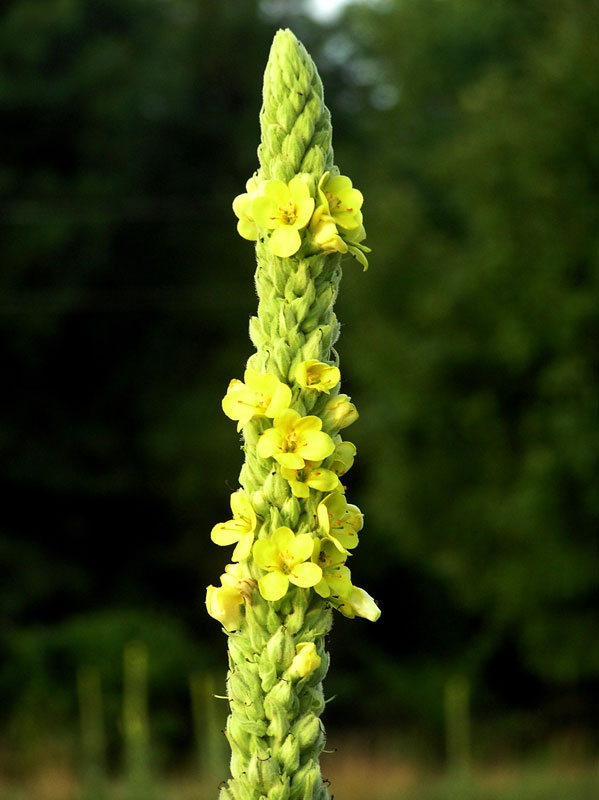Can’t say enough about mullein

Yellow flowers spiralling around the tall Mullein stalk. Photo by Ken Moore.
By Ken Moore Flora Columnist
First I offer a sincere apology that Marie Weiden was not properly identified in last week’s column about Ruellia regarding her colorful curb in Chapel Hill. Beginning with Marie’s garden, I’m looking forward to describing more curbsides as folks share more and more garden enthusiasm and expertise right up front for all to enjoy!
This week my favorite plant is mullein, Verbascum thapsus, also called Wooly Mullein, Velvet-leaf, Flannel-leaf, Jacob’s Staff and even Quaker Rouge. It’s in abandoned fields, on roadsides and even in pavement openings, singly or clustered in patches. But nowhere have I seen a patch equaling what is occurring just south of town. Being very mindful of the busy traffic on Smith Level Road, you may be quick enough to glimpse a magnificent field on the east side, just south of the new Carrboro High School. Hundreds of sage-green mullein, standing tall in that field, provide a southwestern dessert-like scene.
Generally a biennial – growing one year; flowering, fruiting and dying the second year – mullein can also germinate, grow, fruit and die in one year or linger into a third year. It requires a bare patch of ground to survive, so you won’t find it in forests or open spaces dominated by perennials and shrubs. However, its seeds remain viable for up to a hundred years, so it’s ready to take advantage of disturbances to any site.
We have the Quakers to thank for one of the humorous descriptions of mullein. These early settlers were not allowed to use makeup, but rubbing a Wooly Mullein leaf on their faces resulted in a long-lasting ruby blush, thus Quaker Rouge, effective makeup without breaking rules. Having arrived in America with the earliest settlers, mullein has become as honored by Native Americans as are truly native species. Descriptions of medicinal and utilitarian uses are endless. The Lumbee Indians stuffed the flannel-like leaves in their moccasins for added warmth in cold months. Native Americans quickly learned the use of the tall dried flower stems (Jacob’s Staff) as fire torches and, amazingly, the hardness of the dried stems makes mullein a preferred woody stem for the Native American fire-making hand-drill.
Fresh and dried mullein leaves and its yellow flowers have been used effectively as inhalants, teas, infusions, poultices and salves for countless injuries and ailments.
Engaging descriptions of traditional uses of mullein are offered by Tom Brown Jr., the guru of outdoor survival training, in his Tom Brown’s Field Guide: Wild Edible and Medicinal Plants. I also recommend Tom Brown’s The Tracker and The Search for anyone wanting compelling reading about growing up learning the Native American ways of living in harmony with the earth.
And I highly recommend Wooly Mullein as a wild or garden plant. I vividly remember a visit to that grand garden at Chatsworth, home of the Duchess of Devonshire, in central England. Walking along the otherwise immaculately swept wide garden paths, I was curious at all the Wooly Mulleins growing haphazardly on the pathway. The response to my obvious inquiry of one of the gardeners was: “Oh, that’s mullein, a favorite of the Duchess, and we’re instructed not to weed a one of them!â€
My yard pathways are barely obvious, but I could not go through a year without nurturing some Wooly Mullein rosettes to enjoy throughout cold months, anticipating their tall stems in mid-summer.
Email Ken Moore at flora@carrborocitizen.com.
Find more Ken Moore Citizen columns at The Annotated Flora


Comments are closed.